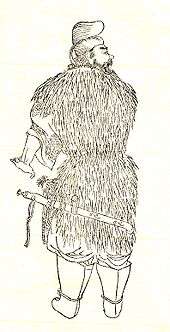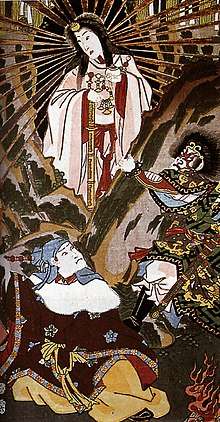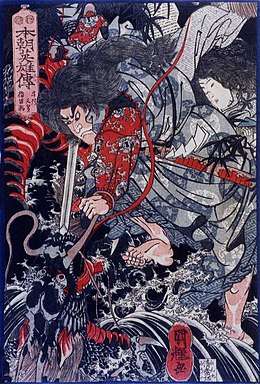Moreya
Moreya or Moriya (洩矢神 Moreya (Moriya)-no-Kami or Moreya (Moriya)-shin) is a Japanese deity who appears in various myths and legends of the Suwa region in Nagano Prefecture (historical Shinano Province). The most famous of such stories is his battle and subsequent defeat under the hands of Takeminakata, also known as Suwa (Dai)myōjin (諏訪大明神), the god of the Grand Shrine of Suwa, who in one version of the myths about him was supposed to have established his rule in the region by subjugating local deities who resisted him.
| Part of a series on |
| Shinto |
|---|
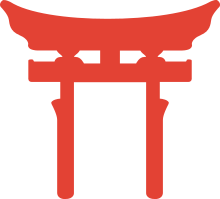 |
| Practices and beliefs |
| Shinto shrines |
| Notable Kami |
| Important literature |
|
| See also |
Moriya is also held to be the ancestor of the Moriya clan (守矢氏), who originally served in one of Suwa Shrine's two sub-shrines, the Upper Shrine (上社 Kamisha) as priests known as Kan-no-Osa (神長) or Jinchōkan (神長官). The Jinchōkan, a hereditary position passed down from father to son, occupied an important position in the Upper Shrine due to his prerogative to summon and dismiss divine spirit(s) called Mishaguji during certain religious rituals of the Upper Shrine.
Due to the similarity of their names, Moriya has been for a long time conflated with the anti-Buddhist Ōmuraji Mononobe no Moriya, who was defeated by the pro-Buddhist Soga clan in 587.
Name
What is currently the most common rendering of Moriya's name in kanji (洩矢) appear in sources such as the Suwa Daimyōjin Ekotoba (1356), where the god is pejoratively referred to as an 'evil outlaw' (洩矢の悪賊 Moriya no akuzoku), and the written genealogy of the Moriya clan, the Jinchō Moriya-shi Keifu (early Meiji period). It is also the rendering adopted by Moriya Shrine (洩矢神社) in Okaya City in Nagano.[1][2]
In addition, a number of texts (see below) refer to the god as Moriya Daijin (守屋大臣), an epithet also used for the historical Mononobe no Moriya.[3][4][5]
Finally, the rendering 守宅[6] is also attested, although this is more commonly applied to Moreya's son, Moriya/Morita (see below).
Mythology
Battle with Suwa Myōjin
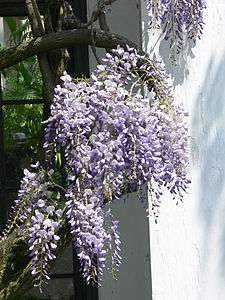
The most famous story involving Moreya is that of his conflict against the god of Suwa Grand Shrine, known either as Takeminakata (the name given to him in the Kojiki and the official histories) or as Suwa (Dai)myōjin.
The basic gist of this myth in most sources involves a certain god (in most sources identified with Suwa Myōjin/Takeminakata) defeating Moreya, who is often described as armed with a certain kind of iron weapon or implement, using only a branch or vine of wisteria.[7][8][9][10][11] Some versions of the story end with the triumphant god planting or discarding the branch, which then turns into a tree or a whole forest of wisterias.
In the Kamisha Monoimi-rei
In Suwa Nobushige's petition
The earliest written version of this myth is found in a petition (解状 gejō) submitted by Suwa Nobushige (諏訪信重), then high priest (Ōhōri) of the Upper Shrine of Suwa, to the Kamakura shogunate in 1249.[12][13] The Upper Shrine was at the time involved in a dispute with the high priest of the Lower Shrine as to which of them was the main shrine of the area, and thus, is to set a precedent in religious rites. Against the Lower Shrine's charges, Nobushige argued for his own shrine's superiority by describing its origin myths and its ceremonies.[14]
In the petition, Nobushige relates a story from "the ancient customs" (舊貫) that the Upper Shrine's precincts was once the land of 'Moriya Daijin' (守屋大臣, lit. 'Chancellor Moriya'), who got into a dispute with a god (明神 Myōjin) who came down from heaven and was seeking to gain possession of his land. After arguments and armed conflicts fail to settle the matter, the two finally compete in a tug of war using hooks (kagi) made out of wisteria (藤鎰) and iron (鐵鎰). After his victory, the god imposed punishment on Moriya and built his dwelling (what would become the Upper Shrine) in Moriya's land. The wisteria, which was planted before the god's dwelling, turned into a grove known as the 'Forest of Fujisuwa' (藤諏訪之森 Fujisuwa no mori), which in turn gave its name to the region.[lower-alpha 1][15][16][17]
In a later passage, Nobushige states that the god brought a mirror (真澄の鏡 Masumi no kagami), a bell (八栄の鈴 Yasaka no suzu), a bridle (轡) and a saddle (唐鞍) with him during his descent from heaven, which were preserved in his day as the Upper Shrine's sacred treasures.[lower-alpha 2][17][18][19]
In the Suwa Daimyōjin Ekotoba and the Suwa Daimyojin Kōshiki
.png)
What is perhaps the most well-known version of the story occurs in Suwa (Kosaka) Enchū's Suwa Daimyōjin Ekotoba (1356) as an origin myth of Fujishima Shrine (藤島社 Fujishima-sha or 藤島大明神 Fujishima Daimyōjin) in Suwa City, one of the Upper Shrine's auxiliary shrines where its yearly rice-planting ceremony is traditionally held.[19][20][21][22] In this version, Moreya is described as an "evil outlaw" (洩矢の悪賊 Moreya no akuzoku) using a ring of iron (鐵輪) as his weapon.
End [of June] - The rice-planting ritual.
The following ceremony is held before Fujishima Shrine (藤島社): the Ōhōri, the priests and other men and women don fresh clothes and come to this place. Gagaku [musicians], bearing farming tools, till the rice fields. With the five chief priests (五官) presiding over the proceedings, the shrine maidens act as rice planters (saotome); appointed performers (職掌 shikishō), meanwhile, beat drums, clap, sing and dance with sasara in their hands. (...) After thirty days the rice ripens and is presented as an offering to the god [of Suwa Shrine] in the first of August. This is one of the [Upper] Shrine's wonders.
As for this so-called Fujishima no Myōjin (藤島明神): long ago, when the revered deity (尊神 sonshin) manifested himself, Moreya the evil outlaw (洩矢の惡賊) sought to hinder the god's stay and fought him with an iron ring (鐵輪), but the Myōjin, taking up a wisteria branch (藤の枝), defeated him, thus finally subduing heresy (邪輪 jarin, lit. "wheel/circle/ring of evil") and establishing the true Dharma. When the Myōjin swore an oath and threw the wisteria branch away, immediately it took root [in the ground], its branches and leaves flourishing in abundance, and [sprouted] beautiful blossoms, leaving behind a marker of the battleground for posterity. 'Fujishima no Myōjin' is named thus for this reason.[lower-alpha 3][23][24]
A record of the Upper Shrine's regulations or taboos (物忌み monoimi)[25] originally enforced in 1238, the Suwa Kamisha butsuki (or: monoimi no) rei no koto (諏訪上社物忌令之事),[26] lists 'Fujishima Daimyōjin' as the first of thirteen middle-rank auxiliary shrines of the Kamisha (中十三所 Chū-jūsansho) and identifies its god as a manifestation of the wrathful Wisdom King Acala (aka Fudō-Myōō).[21][27] Nowadays, the shrine is instead considered to be dedicated to the goddess Konohana-Sakuya-Hime.[28]
The myth is retold in a substantially similar fashion in a Shinto-Buddhist liturgical eulogy (講式 kōshiki) to the Suwa deity believed to have been composed by Enchū around the same time as the Ekotoba known as the Suwa Daimyōjin Kōshiki (諏方大明神講式).[29][30][31]
In Suwa clan genealogies
Two genealogies of the Suwa clan, the Maeda-bon Jinshi Keizu (前田本 神氏系図)[32][33] and the Jinke Keizu (神家系図),[34] contain a somewhat euhemerized variant of the myth: the battle is placed during the reign of the Emperor Yōmei (reigned 585-587), Moreya - again referred to as 'Moriya (Daijin)' (守屋(大臣)) - is apparently conflated with the anti-Buddhist ōmuraji Mononobe no Moriya (died 587), and Suwa Myōjin fights the battle through his avatar, the boy priest Arikazu (有員).[lower-alpha 4][lower-alpha 5]
A Muromachi period work authored by Rinzai monk Ten'in Ryūtaku (天隠龍沢, 1422-1500)[35] known as the Ten'in-goroku (天陰語録) recounts this variant of the myth: here, Arikazu was said to have defeated Moreya/Moriya "at the time of the 32nd human sovereign Emperor Yōmei, (when) Buddhism spread to the east." (人皇卅二代用明天皇、佛法東流之時)[lower-alpha 6][36]
In the Jinchō Moriya-shi Keifu
The Jinchō Moriya-shi Keifu (神長守矢氏系譜), a genealogy of the Moriya clan compiled at the beginning of the Meiji period by Moriya Saneyoshi (守矢実久),[37][38][39] meanwhile identifies Moreya's opponent with Takeminakata as he appears in both the Kojiki and the Sendai Kuji Hongi: a god driven away from the land of Izumo.
When Minakatatomi-no-Mikoto (御名方刀美命) fled from Izumo to the sea of Suwa, the god Moreya (洩矢神) who was dwelling by its shores - a shrine [to whom] is found in the village of Hashihara - resisted him. Though they fought each other using wisteria and iron kagi (藤鑰鐵鑰), [Moreya] finally submitted to the august power of Minakatatomi-no-Mikoto, vowing to give up the land for the god to govern politically and religiously (祭政). Minakatatomi-no-Mikoto recited the following song:
(Man'yōgana) 鹿兒弓乃 眞弓乎持弖 宮滿茂里 矢竹心爾 仕布麻都連與
Kagoyumi no / mayumi o mochite / miya mamori / yatake-gokoro ni / tsukaumatsureyo
("Wielding your bow / made of spindle wood, / protect my dwelling (or 'shrine') / and attend to me / stout-heartedly!")He then planted the wisteria [on the ground], which later grew and became known as the Forest of Fujisuwa (藤洲羽森).[lower-alpha 7]
Moreya and Yatsukao/Ganigawara
Another myth involving Moreya concerns the defeat of the god Yatsukao-no-Mikoto (矢塚男命) also known as Ganigawara (蟹河原長者 Ganigawara-chōja) of Tenpaku-shime Shrine (天白七五三社) in Chino City.[40][41][42]
There is an oral tradition that the shrine's god, Yatsukao-no-Mikoto, dwelt inside a cave in this area ... When Takeminakata-no-Mikoto came to this land, he (Yatsukao?) fought Moreya-no-Kami with bow and arrow. When Yatsukao was struck by the arrow and was about to die, he said to Takeminakata-no-Mikoto, "I should have submitted to you, O great god! I have a daughter - I give her to you." After saying this, he died.[43][lower-alpha 8]
A folk version of the story states that after Moreya's defeat in the hands of the Suwa deity (identified here with Takeminakata of Izumo), Ganigawara, a powerful and wealthy god/chieftain in the region, held Moreya in contempt for surrendering to the foreign god and even had messengers publicly revile him as a coward. When Moreya paid no heed to their insults, Ganigawara's servants began to resort to violence, shooting arrows at the palace Moreya and other deities were erecting for Takeminakata. Takeminakata, considering it an affront, then launched an all-out attack against Ganigawara, who was caught unprepared and thus, was quickly defeated.[44]
Ganigawara, mortally wounded by an arrow in the assault, repents in his deathbed and, via Moreya, entrusts his youngest daughter to Takeminakata. Takeminakata gives her hand in marriage to Taokihooi-no-Mikoto (手置帆負命) a.k.a. Hikosashiri/Hikosachi-no-Kami (彦狭知神),[lower-alpha 9] who was injured by Ganigawara's messengers as he was keeping watch over Takeminakata's abode. Taokihooi then settled down with his new wife in Ganigawara's land, which he also inherited.[44]
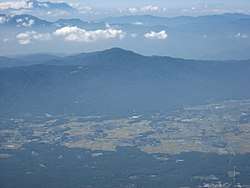
The rain god of Mount Moriya
Behind the Upper Shrine of Suwa, straddling the border between the cities of Suwa and Ina, stands the 1,650 metre-high[48][49] Mount Moriya (守屋山 Moriya-san), which is often claimed to be the shrine's go-shintai.[49][50]
The god of this mountain, usually called Moriya Daijin (守屋大臣), identified with either Moreya[51] (in Suwa Nobushige's petition, the Maeda-bon Jinshi Keizu, and the Jinke Keizu, the mountain is portrayed as the battleground between Suwa Myōjin/the priest Arikazu and 'Moriya Daijin'[17][32][34]) or Mononobe no Moriya (a miniature shrine or hokora located on the mountain's peak is currently considered as the rear shrine or oku no miya (奥宮) of a shrine to the Mononobe chancellor on the slopes of the mountain[52][53]), is traditionally held as a weather deity who causes rain to fall when angered.[54] Local rainmaking rituals once involved provoking the god into sending rain by vandalizing the hokora or throwing it down the mountain side.[49][52][54]
.png)
Popular belief holds that rain falls whenever clouds gather around the mountain top.[48][54] A local folk song advises people to prepare to mow the fields whenever the following signs of incoming rain are observed:
(Man'yōgana) 於自理皮礼 守矢敞雲乎 巻上而 百舌鳥義智奈哿婆 鎌遠登具倍斯
(おじり晴れ 守矢へ雲を 巻き上げて もずぎち鳴かば 鎌をとぐべし)
Ojiri hare / Moriya e kumo o / maki agete / mozu gichi nakaba / kama o togu beshi
"When the sun at Ojiri / pushes clouds / towards (Mount) Moriya / and the shrike (mozu) chatters / sharpen your sickles."<ref name="Yazakip96" /><ref name="Moriyasan">"物部守屋神社奥宮(守屋山の主は…)". 諏訪大社と諏訪神社(附・神社参拝記). 八ヶ岳原人.</ref>
Offspring
The Jinchō Moriya-shi Keifu claims Moreya to have had two children, a daughter named Tamaru-hime (多満留姫) and a son named Moriya[55] (守宅神 or 守矢神[39]) or Morita-no-Kami (守田神).[lower-alpha 10][39][56] Tamaru-hime married Izuhayao (出速雄神), a son of Takeminakata,[lower-alpha 11] while Morita became the father of the god Chikatō (千鹿頭神), who married Urako-hime (宇良古比売命), the goddess of Mount Urako (宇良古山) in modern-day Matsumoto City.[lower-alpha 12][37][57]
Curiously, according to the genealogy Chikatō was succeeded by Kodamahiko (児玉彦命), the son of Katakurabe (片倉辺命), another one of Takeminakata's children, under the orders of the god himself.[37] Kodamahiko was said to have married Mitsutama-hime (美都多麻比売神), the daughter of Moritatsu (守達神) - identified in the genealogy as yet another son of Takeminakata[lower-alpha 13] - and begat the god Yakushi (八櫛神).[lower-alpha 14][37][56]
Analysis
The story of Moreya's battle against Suwa Myōjin/Takeminakata/Arikazu has been interpreted either as a mythicization of a conflict between indigenous Jōmon hunter-gatherers of the Suwa region and agrarian Yayoi peoples who began to settle in the area,[58][59] or between the local clans of Suwa and the expanding Yamato state somewhere during the 6th to 7th centuries CE (Asuka period).[60][61] Accordingly, Moreya is believed by some to be a deified indigenous priest-chieftain or clan leader who once held political and religious authority over the Suwa region.[7][62]
The author Iwao Ōwa (1990) meanwhile theorizes Moreya to be a personification of the guardian nature spirit or Mishaguji worshipped by the Moriya clan. He further proposes that Moreya/Moriya and Moriya/Morita - Moreya's son in the Jinchō Moriya-shi Keifu - were originally a single figure later split into two, with the elder Moriya (Moreya) being connected with hunting and the younger Moriya (Morita) being mostly associated with sedentary agriculture.[63]
Moreya, the Moriya clan and Mononobe no Moriya
The similarity between the names of both Moreya/Moriya and the 6th century Ōmuraji Mononobe no Moriya, who opposed the introduction of Buddhism to Japan, had led to a long-standing conflation of the two figures (cf. Moreya being called Moriya Daijin in medieval texts).
A certain legend claims that a son of Mononobe no Moriya, named either Takemaro (武麿) or Otogimi (弟君), survived the defeat of the Mononobe in the Battle of Mount Shigi in 587 and fled to Suwa, where he married into the Jinchō Moriya clan; Takemaro is thus reckoned as a clan ancestor in the Jinchō Moriya-shi Keifu.[lower-alpha 15][64] A small mound in the Moriya clan's historical estate in Chino dated to the 7th century[65] is claimed in family lore to be Takemaro's tomb.[66]
Ōwa (1990) believes this story to be modelled after the biography of Mononobe no Masara (物部麻佐良), who according to the Sendai Kuji Hongi married Imoko (妹古), the daughter of an unidentified 'Suwa-no-Atai' (須羽直) during the reign of Emperor Buretsu in the late 5th century, yet sees it as at least being inspired by a real-life connection between the Mononobe clan and Shinano Province.[64]
Moriya Shrine in Okaya City where Moreya is worshipped currently denies any connection between the god and the Mononobe chancellor.[67]
Descendants
Moreya is held to be the ancestor of the Moriya clan (守矢氏), which traditionally served as priests of the Suwa Kamisha.[7][68]
The chief priest of the Kamisha was the ōhōri or ōhafuri (大祝 'great priest'), who was considered to be a living deity and the embodiment of Suwa Myōjin, the god of the shrine. Assisting the ōhōri (who by tradition was a member of the Suwa clan, Suwa Myōjin's supposed descendants[7]) were five priests, at the head of which was the kan-no-osa (神長, also jinchō) or jinchōkan (神長官), an office occupied by members of the Moriya clan. The jinchōkan oversaw the Kamisha's rites and ceremonies in general and summoned Mishaguji - a god or gods thought to inhabit rocks or trees worshipped in the region since ancient times[69][70] and regarded by the Moriya as their patron deity - to possess individuals or inanimate objects during ceremonies, being the only one considered to be able to do so.[71]
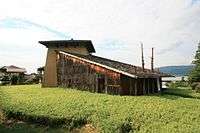
It has been observed that the religious climate of Suwa is a syncretism of ancient indigenous beliefs and practices (e.g. the worship of Mishaguji) reorganized under a Yamato framework (e.g. Suwa Myōjin/Takeminakata, the cult of the ōhōri), but with the local element still predominant. Despite (or perhaps because of) his officially being a living god and the Kamisha's chief priest, the Suwa ōhōri - who assumed the office during childhood - had little, if any, real power or influence in the shrine's affairs, which firmly rested in the hands of the Moriya jinchōkan,[72] with his unique ability to hear Mishaguji and call upon the god(s) to descend upon someone or something[69] and his knowledge of special rituals, which were closely guarded secrets traditionally passed down via word of mouth only to a single individual, the heir to the office of jinchōkan.[73][74]
The establishment of State Shinto in the Meiji period abolished the tradition of hereditary succession among Shinto priests and private ownership of shrines.[75][76][77] Accordingly, the shrine at Suwa passed under the control of the state, with government appointees replacing the clans who had historically served as its priests, the Suwa and the Moriya among them. As the ancient priestly offices of the shrine became defunct, most of the unwritten tradition once guarded by the Moriya jinchōkan died with the last occupant of the position.[73] A museum dedicated to preserving information about the Moriya and documents owned by the family, the Jinchōkan Moriya Historical Museum (神長官守矢史料館 Jinchōkan Moriya Shiryōkan), currently stands on the clan estate in Chino City, Nagano.[78][79]
Shrine
A single shrine to Moreya, Moriya Shrine (洩矢神社 Moriya-jinja), stands in Okaya City, Nagano, near the Tenryū River. On the opposite bank stands Fujishima Shrine (藤島神社 Fujishima-jinja), where legend says Suwa Myōjin stood or encamped during the battle. The other Fujishima Shrine (藤島社 Fujishima-sha), where the wisteria Suwa Myōjin used during the battle was supposedly planted and sprouted, is in Nakasu, Suwa City.[80][81]
See also
Notes
- 「一 守屋山麓御垂跡事
右謹檢舊貫、當砌昔者守屋大臣之所領也、大神天降御之刻、大臣者奉禦明神之居住、勵制止之方法、明神者廻可爲御敷地之祕計、或致諍論、或及合戰之處、兩方難決雌雄、爰明神者持藤鎰、大臣者以鐵鎰、懸此所引之、明神即以藤鎰令勝得軍陣之諍論給、而間令追罰守屋大臣、卜居所當社以來、遙送數百歲星霜、久施我神之稱譽天下給、應跡之方々是新哉、明神以彼藤鎰自令植當社之前給、藤榮枝葉號藤諏訪之森、毎年二ヶ度御神事勤之、自尓以來以當郡名諏方、爰下宮者當社依夫婦之契約示姫大明神之名、然而當大明神、若不令追出守屋給者、爭兩者卜居御哉、自天降之元初爲本宮之條炳焉者哉、」 - 「一 御神寶物事
右大明神天降給之刻、所令御隨身之眞澄鏡、八榮鈴並唐鞍、轡等在之、御鏡者數百歳之間無陰曇、鈴者其音無替、毎年二ヶ度大祝向彼鏡振件鈴致天下泰平之祈請、鞍轡等其色不損 (...)」 - 「晦日。田植。藤島社の前にして此儀あり。大祝の外。神官男女衣服を刷て此所に望む。雅樂農具を帶して田がへす。五官を行事とし。巫女をさうとめとす。職掌大鞁を取。拍子をうち。笛を吹。さゝらを取て歌舞す。(...) 卅日をへて熟稻と成て。八月一日神供に備。當社奇特の其一なり。
抑此藤島の明神と申は。尊神垂迹の昔。洩矢の惡賊神居をさまたげんとせし時。洩矢は鐵輪を持してあらそひ。明神は藤枝を取りて是を伏し給ふ。終に邪輪を降して正法を興す。明神誓を發て。藤枝をなげ給しかば。則根をさして枝葉をさかへ花蘂あざやかにして。戰場のしるしを萬代に殘す。藤島の明神と號此故也。」 - 「神幸信州諏方郡者、人皇卅二代用明天皇御宇也。于時、有八歳童子後字有員而令隨遂明神守屋奉諍。大神至守屋山、有御合戰。童子率神兵、追落守屋。則于彼山麓構社壇。吾神脱着御衣於童子。『吾無躰、以祝爲躰。』有神勅、隱給御身。即彼童子爲神躰、名御衣木祝、神氏始祖也。明神者普賢、童子者文殊也。」[32]
- 「用明天皇御宇、大明神影向信濃國諏方郡之時、爲有員童子形体、令御共也。爰同郡守屋大臣奉諍。大明神御來臨之間、至守屋山、彼大臣與大明神在御合戰。于時、有員令御共致合戰、忠追落大臣。則於守屋山麓構社壇、令化現諏訪大明神。即有員始而爲祝奉成祭禮者也。豈大明神者普賢、有員者文殊師利菩薩化身云々。][34]
- 「神之顯於科野國者。人皇卅二代用明天皇佛法東流之時也。有八歲童子。其名爲有員。隨神以信州也。大臣守屋拒之。童子率兵神以力戰。守屋敗績。弃甲以走。童子追之。就守屋城下。」
- 「洩矢神:御名方刀美命、逃出雲到于洲羽海之時、有洩矢神者居海畔(橋原村社有)拒之、藤鑰鐵鑰以雖有互相爭事、遂服御名方富命御稜威、誓曰奉乎地永主命之祭政。御名方刀美命歌曰、鹿兒弓乃眞弓乎持弖宮滿茂里矢竹心爾仕布麻都連與。揷彼藤、後繫茂弖曰藤洲羽森。」
- 「永明村天白七五三社由緒ニ、字宮渡祭神矢塚男命此地ニ穴居ス、健御名方命此國ニ到リシ時洩矢神ト弓矢を以テ戦フ、矢塚男其矢ニ中リテ死セントシ、建御名方命ニ云フ、我ハ大神ニ随フベシ、一女アリ献ラムト言ヒ終テ死ストノ口傳アリ (下畧)」[43]
- Both Taokihooi and Hikosachi - identified as two distinct individuals - appear in the Nihon Shoki[45][46] and the Kogo Shūi[47] as ancestors of the Inbe clan (忌部氏).
- 「守宅神:生弖有靈異幹力、代父弖負弓矢、從大神遊獵得千鹿。有一男、名之曰千鹿頭神。」[37]
- 「洩矢神 (...) 有一男一女、女曰多滿留姫、嫁大神御子出速雄神。」[37]
- 「千鹿頭社 諏訪郡ノ内鎭座 有賀 上原
原田 横吹 休戸 東筑摩郡 神田 林
同地宇良古山ニ鎭座ス往古ハ郡内三十餘村ノ祭神ナリ 后神ヲ宇良古比賣命ト云口碑ニ傳フ由同地ニ命ノ社アリ」 - 「守達神:健御名方命之御子也。」[37]
- 「兒玉彦命:大神御子片倉邊命之御子也。大神之御言之隨、千鹿頭神之跡乎繼弖主祭政。守達神御子、美都多麻比賣神乎娶弖、八櫛神乎生。」[37]
- 「武麿 (一云弟君): 三十一代用命天皇御宇 物部守屋大連守屋大臣ハ饒速日命苗裔 尾輿大連ノ子爲國殞身河内國澁川館兒孫逃匿葦原或逃、亡長子雄君入美濃、次子武麿入于信濃洲羽來弖娶神氏女嗣長職。」[37]
References
- "Moriya Shrine Official Website (洩矢神社公式HP)".
- Nihon Kōtei Keizu (日本皇帝系図), in Hanawa Hokiichi, ed. (1973). 群書系図部集 第二 (Gunsho keizubushū, vol. 2). Zoku Gunsho-ruijū Kanseikai. p. 51. ISBN 9784797102741.
- Dickson, Walter G. (1889). Gleanings from Japan. W. Blackwood and Sons. p. 360.
- Arai, Hakuseki (1963). The Sword Book in Honchō Gunkikō and the Book of Samé Ko Hi Sei Gi of Inaba Tsurio. Translated by Joly, Henri L.; Inada, Hogitarō. Charles E. Tuttle. p. 14.
- Fukuyama, Toshihisa, ed. (1912). 信濃史蹟 (Suwa shiseki) (in Japanese). Shinano shinbunsha. p. 18-19.
- Moriya, Sanae (1991). Moriya-jinchō-ke no ohanashi (守矢神長家のお話し). In Jinchōkan Moriya Historical Museum (Ed.). Jinchōkan Moriya Shiryōkan no shiori (神長官守矢資料館のしおり) (Rev. ed.). pp. 2–3. (in Japanese)
- Miyasaka, Mitsuaki (1987). "Kyodai naru kami no kuni. Suwa-shinkō no tokushitsu (強大なる神の国―諏訪信仰の特質)." In Miyasaka, Mitsuaki (1987). "Kyodai naru kami no kuni. Suwa-shinkō no tokushitsu (強大なる神の国―諏訪信仰の特質)." In Ueda; Gorai; Ōbayashi; Miyasaka, M.; Miyasaka, Y. Onbashira-sai to Suwa-taisha 御柱祭と諏訪大社 (in Japanese). Nagano: Chikuma Shobō. p. 21. ISBN 978-4480841810.
- Oh, Amana ChungHae (2011). Cosmogonical Worldview of Jomon Pottery. Sankeisha. pp. 157–159. ISBN 978-4-88361-924-5.
- Yazaki, Takenori, ed. (1986). Suwa-taisha 諏訪大社. Ginga gurafikku sensho (in Japanese). 4. Ginga shobō. pp. 24–25.
- Rekishi REAL Henshūbu (歴史REAL編集部), ed. (2016). Jinja to kodai gōzoku no nazo 神社と古代豪族の謎 (in Japanese). Yosensha. p. 39. ISBN 978-4800308924.
- Miyasaka (1987), p. 21.
- Miyasaka (1992), pp. 92-93.
- Suwa Shishi Hensan Iinkai (諏訪市史編纂委員会), ed. (1995). "'Ōhōri Nobushige gejō' to 'Suwa Daimyōjin Ekotoba'" 「大祝信重解状」と『諏方大明神画詞』. Suwa Shishi, vol. 1 諏訪市史 上巻 原始・古代・中世. Suwa. pp. 811–814.
- Miyachi, Naokazu (1931a). Suwa-shi, vol. 2, part 1 諏訪史 第二卷 前編 (in Japanese). 信濃教育会諏訪部会 (Shinano kyōikukai Suwa-bukai). p. 76.
- Miyachi, Naokazu (1931b). Suwa-shi, vol. 2, part 2 諏訪史 第二卷 後編 (in Japanese). 信濃教育会諏訪部会 (Shinano kyōikukai Suwa-bukai). pp. 47–48.
- Suwa Nobushige Gejō (諏訪信重解状), in Suwa Kyōikukai (諏訪教育会), ed. (1931). 諏訪史料叢書 巻15 (Suwa shiryō-sōsho, vol. 15) (in Japanese). Suwa: Suwa Kyōikukai.
- Miyachi (1931b). p. 126.
- Suwa Shishi Hensan Iinkai, ed. (1995). "Suwa-jinja Kamisha Shimosha (諏訪神社上社・下社)". pp. 681-683.
- Miyasaka (1992). pp. 88-91.
- "藤島社・藤島大明神". 諏訪大社と諏訪神社(附・神社参拝記). 八ヶ岳原人.
- "諏訪大社上社「御田植祭」". 諏訪大社と諏訪神社(附・神社参拝記). 八ヶ岳原人.
- Hanawa, Hokiichi, ed. (1914). Suwa Daimyōjin Ekotoba 諏訪大明神繪詞. Zoku Gunsho-ruijū (続群書類従) (in Japanese). 3. Zoku Gunsho-ruijū Kanseikai. p. 530.
- Kanai, Tenbi (1982). Suwa-shinkō-shi 諏訪信仰史 (in Japanese). Meicho Shuppan. p. 262.
- Iwai, Hiroshi. "Monoimi". Encyclopedia of Shinto. Kokugakuin University.
- Takei, Masahiro (1999). "Saiji wo yomu: Suwa Kamisha butsukirei no koto" 祭事を読む-諏訪上社物忌令之事-. 飯田市美術博物館 研究紀要 (Bulletin of the Iida City Museum). 9: 121–144.
- Takei (1999). p. 135.
- Miyasaka (1992). p. 91.
- "諏方大明神講式". National Institute of Japanese Literature (国文学研究資料館).
- 諏方大明神講式 (Suwa Daimyōjin Kōshiki), in Shintō Taikei Hensankai, ed. (1982). 神道大系 神社編30 諏訪 (Shintō Taikei Jinja-hen, 30: Suwa). Tokyo: Shintō Taikei Hensankai. pp. 9, 237ff.
- Fukuda, Akira; Nihonmatsu, Yasuhiro; Tokuda, Kazuo (2015). 諏訪信仰の中世―神話・伝承・歴史 (Suwa Shinko no Chusei: Shinwa, Densho, Rekishi). Miyai Shoten. pp. 119–123. ISBN 978-4838232888.
- 神氏系図 (Jinshi Keizu), in Miyachi, Naokazu (宮地直一) (1931). Suwa-shi, vol. 2, part 1 諏訪史 第二卷 前編. Shinano kyōikukai Suwa-bukai (信濃教育会諏訪部会).
- Kobuzoku Kenkyūkai, ed. (2017). 古代諏訪の祭祀と氏族 (Kodai Suwa no Saishi to Shizoku) (in Japanese). Ningen-sha (人間社). p. 88. ISBN 978-4908627163.
- 神家系図 (Jinke Keizu), in Suwa Kyōikukai (諏訪教育会), ed. (1931). Suwa shiryō-sōsho, vol. 28 諏訪史料叢書 巻28 (in Japanese). Suwa: Suwa Kyōikukai.
- "天隠竜沢". kotobank - デジタル版 日本人名大辞典+Plus. Kōdansha, The Asahi Shimbun Company, VOYAGE GROUP, Inc.
- Hanawa, Hokiichi, ed. (1914). Ten'in-goroku (天陰語録). Zoku Gunsho-ruijū (続群書類従) (in Japanese). 13. Zoku Gunsho-ruijū Kanseikai. p. 413. ISBN 9784797100631.
- Jinchō Moriya-shi Keifu (神長守矢氏系図), in Suwa Kyōikukai (諏訪教育会), ed. (1931). Suwa shiryō-sōsho, vol. 28 諏訪史料叢書 巻28 (in Japanese). Suwa: Suwa Kyōikukai.
- Ōta, Akira (1926). Suwa-jinja-shi: Volume 01 諏訪神社誌 第1巻 (in Japanese). pp. 15–16.
- Suwa-jinja-kyūki (諏訪神社旧記), as cited in Miyachi, Naokazu (1931). Suwa-shi, vol. 2, part 1 諏訪史 第二卷 前編. 信濃教育会諏訪部会 (Shinano kyōikukai Suwa-bukai). p. 76.
- Kobuzoku Kenkyūkai, ed. (2017). p 79.
- "蟹河原(がにがわら)". 諏訪大社と諏訪神社(附・神社参拝記). 八ヶ岳原人.
- "蟹河原 (茅野市ちの横内)". たてしなの時間. 蓼科企画.
- Shinano-no-kuni Kansha Suwa-jinja Jinchōkan Moriya-ke Ryaku-keizu (信濃國官社諏訪神社神長官守矢家略系圖), in Nobukawa, Kazuhiko (延川和彦); Iida, Kotaro (飯田好太郎) (1921). 諏訪氏系図 続編 (Suwa-shi Keizu, Zokuhen). p. 19.
- Imai, Nogiku (今井野菊) (1960). 諏訪ものがたり (Suwa Monogatari). Kōyō Shobō (甲陽書房). pp. 42–49.
- Aston, William George (1896). . . London: Kegan Paul, Trench, Trübner & Co. p. 81 – via Wikisource.
Thereupon Ta-oki-ho-ohi no Kami, ancestor of the Imbe of the Land of Kii, was appointed hatter, Hiko-sachi no Kami was made shield-maker ...
[scan
- . – via Wikisource.
既以紀伊國忌部遠祖手置帆負神、定爲作笠者。狹知神、爲作盾者。
- – via Wikisource.
手置帆負命。讚岐國忌部祖也。產狹知命。紀伊國忌部祖也。
- Yazaki (1986). p. 96.
- "守屋山". 信州山岳ガイド. The Shinano Mainichi Shimbun.
- "Suwa Taisha Shrine". Japan Visitor.
- Miyasaka (1992). p. 93.
- "物部守屋を祀る物部守屋神社". 諏訪大社と諏訪神社(附・神社参拝記). 八ヶ岳原人.
- Kobuzoku Kenkyūkai, ed. (2017). pp. 80-81.
- Ōwa, Iwao (1989). Jinja to kodai minkan saishi (神社と古代民間祭祀) (in Japanese). Hakusuisha. p. 40. ISBN 978-4560022269.
- Jinchōkan Moriya Historical Museum (Ed.) (1991). Jinchōkan Moriya Shiryōkan no shiori (神長官守矢資料館のしおり) (Rev. ed.). p. 10.
- "千鹿頭神・宇良古山・宿世結神・逢初川 (松本市神田・林)". 諏訪大社と諏訪神社(附・神社参拝記). 八ヶ岳原人.
- Tanaka, Atsuko. 古社叢の「聖地」の構造(3)─諏訪大社の場合 (PDF). Journal of Kyoto Seika University (in Japanese): 122–123.
- 古代史ミステリー 「御柱」~最後の"縄文王国"の謎~ (Kodaishi Mystery. Onbashira: Saigo no Jōmon-ōkoku no nazo) (Documentary) (in Japanese). Japan: NHK. 2016.
- Miyasaka (1987), pp. 18-22.
- Oh (2011), pp. 156-157.
- Oh (2011). pp. 158-159.
- Ōwa, Iwao (1990). Shinano Kodai Shikō (信濃古代史考). Tokyo: Meicho shuppan. pp. 201–202. ISBN 978-4626013637.
- Ōwa (1990). pp. 110-111.
- "神長官裏古墳". 古墳マップ (Kofun Map).
- Moriya (1991). pp. 6-7.
- "洩矢神社とは". 洩矢神社公式HP (Moriya Shrine Official Homepage).
- Rekishi REAL Henshūbu (2016). p. 40.
- Moriya (1991), p. 4.
- "ミシャグジ (Mishaguji)". やおよろず 日本の神様辞典 (Yaorozu - Nihon no kamisama jiten).
- Miyasaka (1987). p. 22.
- Oh (2011), p. 158.
- Moriya (1991), p. 5.
- Miyasaka (1987). p. 27.
- Earhart, H. Byron (2013). Religion in Japan: Unity and Diversity. Cengage Learning. p. 199. ISBN 978-1285528816.
- Josephson, Jason Ananda (2012). The Invention of Religion in Japan. University of Chicago Press. p. 150. ISBN 9780226412351.
- "Becoming a Shintō Priest or Priestess Titles-Roles of Men & Women Serving Shrines".
- "神長官守矢資料館". 武田氏の史跡探訪.
- Buntrock, Dana (2013). Materials and Meaning in Contemporary Japanese Architecture: Tradition and Today. Routledge. p. 17. ISBN 978-1-134-72501-4.
- "藤島社・藤島大明神 諏訪市中洲神宮寺". 八ヶ岳原人.
- Miyachi (1992), pp. 91-93.
Bibliography
- Imai, Nogiku (1960). 諏訪ものがたり (Suwa Monogatari). Kōyō Shobō (甲陽書房).
- Jinchōkan Moriya Historical Museum, ed. (1991). Jinchōkan Moriya Shiryōkan no shiori (神長官守矢資料館のしおり) (Rev. ed.). (in Japanese)
- Kobuzoku Kenkyūkai, ed. (2017). 古代諏訪の祭祀と氏族 (Kodai Suwa no Saishi to Shizoku) (in Japanese). Ningen-sha (人間社). ISBN 978-4908627163.
- Miyasaka, Mitsuaki (1992). 諏訪大社の御柱と年中行事 (Suwa-taisha no Onbashira to Nenchu-gyōji) (in Japanese). Kyōdo shuppansha. ISBN 978-4-87663-178-0.
- Miyachi, Naokazu (1931). 諏訪史 第二卷 前編 (Suwa-shi, vol. 2, part 1) (in Japanese). Shinano kyōikukai Suwa-bukai.
- Miyachi, Naokazu (1937). 諏訪史 第二卷 後編 (Suwa-shi, vol. 2, part 2) (in Japanese). Shinano kyōikukai Suwa-bukai.
- Oh, Amana ChungHae (2011). Cosmogonical Worldview of Jomon Pottery. Sankeisha. ISBN 978-4-88361-924-5.
- Ōta, Akira (1926). 諏訪神社誌 第1巻 (Suwa-jinja-shi: Volume 01) (in Japanese).
- Suwa, Enchū (1914). 諏訪大明神繪詞 (Suwa-daimyōjin ekotoba) in Hanawa, Hoki'ichi (ed.), 続群書類従 (Zoku Gunsho-Ruijū). Tokyo: Zoku Gunsho-Ruijū Kanseikai. pp. 494–539. (Original work written 1356) (in Japanese)
- Ueda, Masaaki; Gorai, Shigeru; Miyasaka, Yūshō; Ōbayashi, Taryō; Miyasaka, Mitsuaki (1987). 御柱祭と諏訪大社 (Onbashira-sai to Suwa-taisha) (in Japanese). Nagano: Chikuma Shobō. ISBN 978-4-480-84181-0.
External links
- Official website of Moriya Shrine (洩矢神社公式HP) (in Japanese)
- Jinchōkan Moriya Historical Museum on Chino City's official website (in Japanese)
